 |
|
 |
| |
发行人:林恭如所长 编辑委员:吴肇欣教授 主编:林筱文 发行日期:2015.10.30 |
| |
|
|
 |
|
本所11月份演讲公告:
|
日期
|
讲者简介 |
讲题 |
地点 |
时间 |
|
光电所专题演讲 |
|
11/6 (Fri) |
邱尔德教授
国立阳明大学生医光电暨分子影像研究中心
|
How Optical Microrheology & Microscopy Quantify Biophysical Markers to Complement the Biochemical at Cellular and Sub-cellular Level? |
博理馆
101演讲厅 |
16:30~18:00 |
|
11/16 (Mon) |
Prof. David J. Hagan
CREOL, UCF |
Nonlinear refraction and absorption: Mechanisms, Characterization and Applications |
电机二馆
105演讲厅 |
14:30~16:00 |
|
11/20 (Fri) |
郑木海教授
国立中兴大学光电工程研究所客座教授
|
待订 |
博理馆
101演讲厅 |
16:30~18:00 |
|
11/27 (Fri) |
Dr. Robert Coffie
The Founder and President of RLC Solutions, LLC |
Electron Trapping and Electric Field Management in AlGaN/GaN High Electron Mobility Transistors |
博理馆
101演讲厅
|
16:30~18:00 |
|
|
 |
|
 |
|
| |
|
|
 |
|
9月份「光电所专题演讲」花絮(花絮整理:姚力琪) |
|
时间: |
2015年9月18日(星期五)下午4点30分 |
|
讲者: |
林峰辉教授(国立台湾大学医学工程学研究所) |
|
讲题: |
The Development of Nanoparticles on Cell Imaging Tracking |
|
|
林峰辉教授于9月18日(星期五)莅临本所访问,并于博理馆101演讲厅发表演说。林教授本次演讲题目为「The Development of Nanoparticles on Cell Imaging Tracking」。本所教师及学生皆热烈参与演讲活动,演说内容丰富精彩,与现场同学互动佳,师生皆获益良多。 |
|
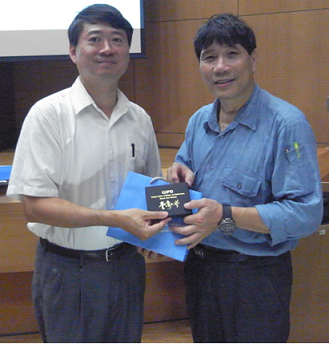 |
|
林峰辉教授(右)与本场演讲主持人黄升龙教授(左)合影 |
|
|
时间: |
2015年9月22日(星期二)上午10点30分 |
|
讲者: |
Prof. Mona Jarrahi (Electrical Engineering Department, University of California Los Angeles) |
|
讲题: |
New Frontiers in Terahertz Technology |
|
|
Prof. Mona Jarrahi于9月22日(星期二)莅临本所访问,并于博理馆101演讲厅发表演说。Prof. Jarrahi本次演讲题目为「New
Frontiers in Terahertz Technology」。本所教师及学生皆热烈参与演讲活动,演说内容丰富精彩,与现场同学互动佳,师生皆获益良多。 |
|
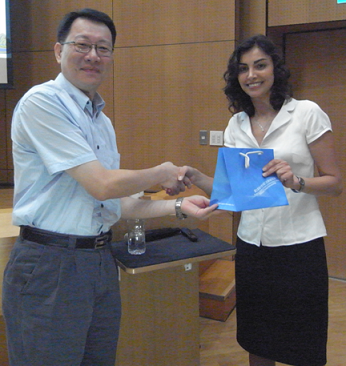 |
|
Prof. Mona Jarrahi(右)与本所所长林恭如教授(左)合影 |
|
|
|
时间: |
2015年9月25日(星期五)下午4点30分 |
|
讲者: |
张守进教授(国立成功大学电机系) |
|
讲题: |
InGaN-based Photonic Devices with tunnel-junction-cascaded structure |
|
|
张守进教授于9月25日(星期五)莅临本所访问,并于博理馆101演讲厅发表演说。张教授本次演讲题目为「InGaN-based Photonic Devices
with tunnel-junction-cascaded structure」。本所教师及学生皆热烈参与演讲活动,演说内容丰富精彩,与现场同学互动佳,师生皆获益良多。 |
|
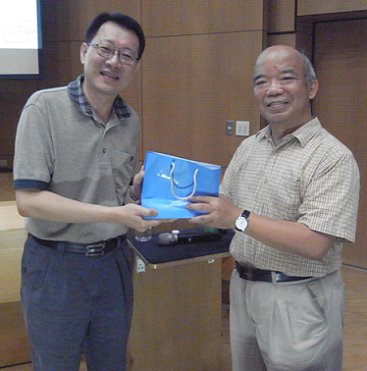 |
|
张守进教授(右)与本所所长林恭如教授(左)合影 |
|
|
|
|
|
 |
|
 |
|
| |
|
|
 |
Plasmon-enhanced Photoluminescence of an Amorphous Silicon Quantum Dot Light-Emitting Device by Localized Surface Plasmon Polaritons in Ag/SiOx:a-Si QDs/Ag Sandwich Nanostructures
Professor Hoang-Yan Lin
Graduate Institute of Photonics and
Optoelectronics, National Taiwan University
台湾大学光电所 林晃岩教授
We investigated experimentally the plasmon-enhanced photoluminescence of the amorphous silicon quantum dots (a-Si QDs) light-emitting devices (LEDs) with the Ag/SiOx:a-Si QDs/Ag sandwich nanostructures (Fig. 1), through the coupling between the a-Si QDs and localized surface plasmons polaritons (LSPPs) mode, by tuning a one-dimensional (1D) Ag grating on the top. The coupling of surface plasmons at the top and bottom Ag/SiOx:a-Si QDs interfaces, resulting in the localized surface plasmon polaritons (LSPPs) confined underneath the Ag lines, which exhibit the Fabry–Pérot resonance. From the Raman spectrum, it proves that the existence of a-Si QDs embedded in Si-rich SiOx film (SiOx:a-Si QDs) at a low annealing temperature (300℃) to prevent the possible diffusion of Ag atoms from Ag film. The photoluminescence (PL) spectra of a-Si QDs can be precisely tuned by a 1D Ag grating with different pitches and Ag line widths (Fig. 2) were investigated. An optimized Ag grating structure, with 500 nm pitch and 125 nm Ag line width, was found to achieve up to 4.8-fold PL enhancement at 526 nm and 2.46-fold PL integrated intensity compared to the a-Si QDs LEDs without Ag grating structure, due to the strong a-Si QDs–LSPPs coupling (Fig. 3). (International Journal of Photoenergy (Volume 2015 (2015), Article ID 140617)
|

|
|
Fig. 1. Schematic view of a-Si QDs LEDs with a Ag/SiOx:a-Si QDs/Ag sandwich nanostructures. |
|
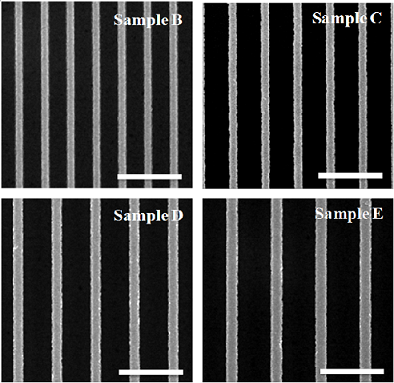
|
|
Fig. 2. SEM images of a series of Ag gratings (samples B-E). Scale bar is 1 μm. |
|
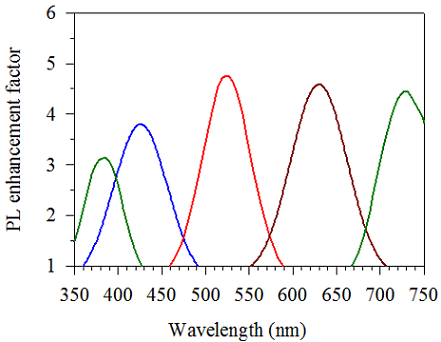
|
|
Fig. 3. The plots of the PL enhancement factor of samples B-E. |
Direct QAM-OFDM Encoding of a Master-to-Slave Injection-Locked WRC-FPLD Pair for 28×20 Gbit/s DWDM-PON Transmission
Professor
Gong-Ru Lin’s Laboratory
Graduate Institute of Photonics and
Optoelectronics, National Taiwan University
台湾大学光电所 林恭如教授
This work demonstrated a master-to-slave injection-locked weak-resonant-cavity Fabry-Perot laser diode (WRC-FPLD) pair, which is capable of carrying an orthogonal frequency division multiplexed 16-quadrature amplitude modulation (16-QAM OFDM) data at 20 Gbit/s/channel for 28 channels in a dense wavelength division multiplexing passive optical network (DWDM-PON), as illustrated in Fig. 1. Since the lower front-facet reflectance and longer cavity features of WRC-FPLD, it reveals broader gain spectrum with denser longitudinal modes and higher injection efficiency than a typical FPLD for supporting more DWDM channels. As a result, the optical spectra of master and slave WRC-FPLDs are shown in Fig. 2. After passing through a demultiplexer with a channel spacing of 50 GHz for the central mode of master WRC-FPLD, the filtered single-mode master with a peak power of -4 dBm was employed to injection-lock the slave WRC-FPLD, which achieves a side-mode suppression ratio (SMSR) of 50 dB. Moreover, the bit error rate (BER) performances of back-to-back and 25-km single-mode fiber (SMF) transmitted 20-Gbit/s OFDM data carried by the master-to-slave injection-locked WRC-FPLD pair at different channels are shown in Fig. 3. For the central mode injection case, the back-to-back transmitted BER of 1.6×10-5 can be improved to 2.9×10-7 by employing the OFDM subcarrier per-leveling technique, and it is inevitably degraded to 2.1×10-4 due to the fiber dispersion after 25-km SMF transmission. To meet the forward error correction (FEC) the required BER of 3.8×10-3, 28 DWDM channels can be obtained to reveal a total data-rate of 28×20=560 Gbit/s. Therein, a slightly decreased SMSR of 35 dB is also obtained for the farthest side-mode injection case. In conclusion, the master-to-slave injection-locked WRC-FPLD pair has shown its competitive performance and superior flexibility to fit multi-channel DWDM-PON transmission.
|

|
|
Fig. 1. The schematic diagram of the master-to-slave injection-locked WRC-FPLD pair based DWDM-PON system for direct 16-QAM OFDM modulation and transmission. |
|
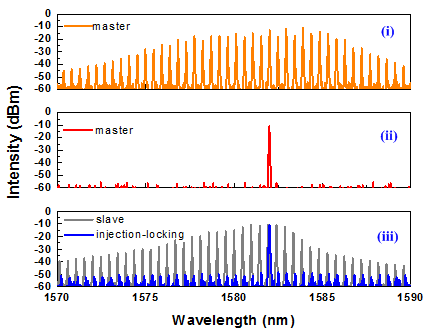
|
|
Fig. 2. The optical spectra of master and slave WRC-FPLDs. |
|
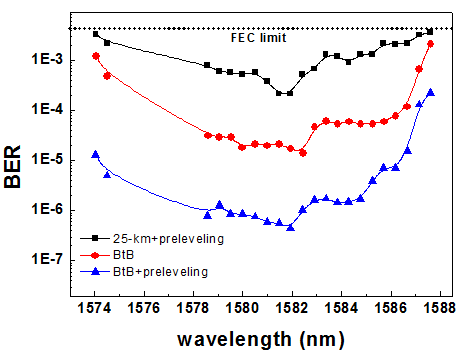
|
|
Fig. 3. The BER performances of back-to-back and 25-km SMF transmitted 28-Gbit/s 16-QAM OFDM data. |
|
 |
| |
|
|
|
 |
|
| |
|
|
 |
论文题目:微结构在三维集成电路及太阳能电池之电磁与半导体特性模拟
姓名:林俊宏 指导教授:邱奕鹏教授
| 摘要 |
|
使用铜硅通孔(TSV)技术,三维芯片集成电路封装(3D-IC)的衬底耦合(substrate coupling)是一个被广泛记载在最近文献的处理困境。且讨论仍仅限于电磁理论框架,使得噪声传播和吸收的一个完整的理解受到阻碍。深入考察了铜硅通孔的这些现象,且从半导体物理和电磁理论的综合观点和调查来深入探讨,采用p+保护环及接地铜硅通孔的组合且透过三维组件仿真来深入探讨降低噪声的方法。使用闪耀光栅在薄膜单晶硅太阳能电池可望用光微影术及离子束蚀刻来达成,是一种前途看好的低成本及高效率太阳能电池的应用。我们执行极化相关的二维数值模拟基于严格耦合波分析法及有限元素法来达到太阳能结构光吸收的最佳化。在电性方面,背表面场层(BSF)是由重掺杂受体来形成,建立了一个浓度梯度,且此层是放在闪耀光栅上面来提供一个额外小的漂移电场来帮助收集少数载子电子。整合最佳化抗反射层及背表面场层和闪耀光栅在2
μm厚的太阳能电池可使效率(cell efficiency)成长两倍。光学设计在提高III族氮化物(group-III-nitride)和多层量子井超晶格为主的氮化铟镓/硅(InxGa1-xN/cSi)双结迭层发光太阳能电池(light emitting solar cell)且具有三角形衍射光栅(triangular diffraction grating)的光吸收模拟和优化通过使用组合的二维严格耦合波分析和转移矩阵的方法(combined two-dimensional rigorous coupled wave analysis and transfer matrix methods)。此组件在顺偏下亦可为发光二极管。本文彻底检查光吸收受抗反射涂层,多个薄膜层及三角形衍射光栅的影响透过半导体物理和电磁理论结合的综合观点来讨论这些现象。相比于原型双结迭层发光太阳能电池获得有58%的光吸收的改进,这意味着80%以上的入射光(hυ
> EgSi)可在该薄膜设计(共小于 < 4微米)被吸收而转换为电能。
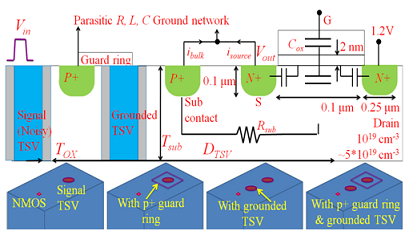 |
|
图一、三维集成电路铜硅通孔的衬底耦合 |
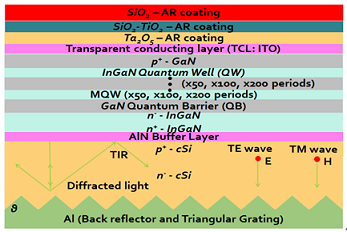 |
|
图二、氮化铟镓/硅双结迭层太阳能电池 |
|
论文题目:血液之兆赫波光谱学
姓名:曾子芳 指导教授:孙启光教授
| 摘要 |
|
血液在自然界中是最复杂的混合液体之一,用以输送许多油脂、葡萄糖、盐类、与蛋白质等分子至身体各处。目前检验这些分子没有非体外的方式,而体外检验中最常使用的生化与光学方法需要先做血浆血球分离。兆赫波在近二十年的研究中已被指出对许多生化分子的震动和转动非常灵敏,相较于现行的检验方法,兆赫波是唯一有机会观察活体内全血中的分子运动并做检测的工具。
在本论文中我们先取29位未加抗凝剂,与29位加了抗凝剂(肝素)的体外血检体(符合取样前空腹八小时的标准),做实时性及长时间的兆赫波频谱量测。我们发现在频率低于一兆赫的波段,血液吸收常数与血小板数目呈正相关,而此现象应是由血小板引发的凝血初阶段一连串生化反应造成。然而后阶段的血液固化过程在统计上并未看出其对血液吸收常数造成上升或下降的作用。而在没有凝血反应的血液中我们发现,三酸甘油脂在正常范围内,和高频的兆赫波血液的兆赫波吸收呈现负相关;而对所有的血液样本,其低频的兆赫波吸收由红血球数目主导,并与红血球数目有负相关。
为了未来非侵入式医疗检测的应用,我们架设了一个近场穿透式兆赫波影像系统来量测在频率低于一兆赫的波段,活体内的血液折射率与吸收常数。我们利用本实验室过去提出的低损耗与低发散角度的管型兆赫波波导当平行光发射源,并以开口为次波长大小的金属方形波导当能量接收器,在活体样本表面近场距离内做二维扫描,以分辨出组织中次波长直径的血管。实验结果在活体裸鼠耳朵中,兆赫波穿透影像能成功显现血管的所在位置。另外,我们也进一步利用数值模拟,量化血液吸收常数变化造成血管能量穿透率的变化,以方便未来非侵入式检测之应用。
 |
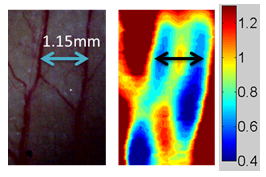 |
|
图一、一兆赫以下28个血液样本的吸收频谱 |
图二、活体裸鼠耳朵在兆赫波照射
下取得之近场影像(左:光学照片,右:兆赫波影像) |
|
|
|
 |
|
 |
|
| |
|
|
 |
— 资料提供:影像显示科技知识平台 (DTKP, Display Technology
Knowledge Platform) —
—
整理:林晃岩教授、林暐杰 —
磁性机会
最近,一个巧妙设计的聚合物材料被展示出在外加磁场时会发光,如此可以产生新型的感应器不需要电接触,并且可以提供视觉反应。Jianhua Hao和他在中国香港理工大学的同事合成一种复合材料(如图 1),此复合材料是基于聚合物聚二甲基硅氧烷(PDMS)所合成,含有一层铁钴镍合金颗粒以产生磁弹性体,以及另一层掺杂金属离子的硫化锌微粒单层以作为压电荧光体。当施加一磁场于材料会诱导可见光发光,这是由于磁场引发弹性体的感应磁致伸缩应变;进而引发荧光体的力致发光。
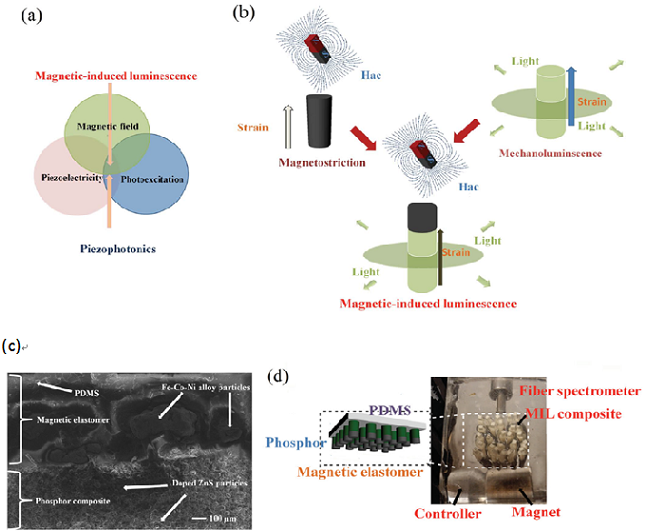 |
|
图1、a) 压电光电子和磁致放光的示意图。b) 磁致放光效应的实施是基于应变介导的磁致放光,是磁弹性体和力致发光荧光粉的两相耦合的结果。c) 铁钴镍合金颗粒以产生磁弹性体层与掺杂金属离子的硫化锌微粒单层之界面SEM图。d) 磁致放光的组件与量测架构。 |
初步的实验显示(如图2),在室温下施加3.5千奥斯特或更高的磁场于该材料,可产生明亮的白色和绿色的光。光产生的效率估计为每奥斯特0.0014流明。发光是可逆且动态的,且能够在以50赫兹频率变化的磁场下反应。
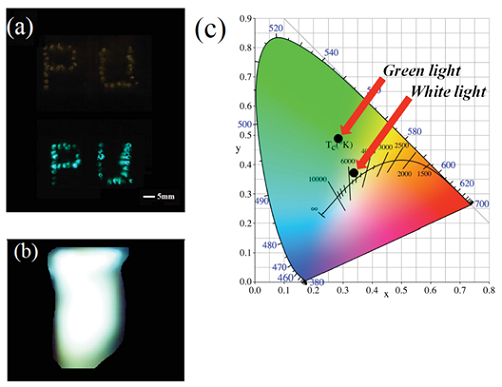 |
|
图2、a) 照片显示绿色的标志"PU"代表香港理工大学的缩写。磁致发光材料在低磁场施加下如下图,无磁场施加下为上图。b) 磁致发光光源在磁场施加下发出的白光,绿色的字与白色光源皆可用肉眼看到。c) 基于磁致发光的图案和光源下的绿光与白光在CIE图中的表现。 |
Hao说:「原则上,当红色或蓝色力致发光荧光体使用情况下,其它颜色包括红色或蓝色是可被呈现的。」「最近在我们的实验室中,我们已经成功地合成了一种能够发出较长时间红光的复合材料。」目标是实现RGB全彩发光,这将证明其在显示器,照明和传感器是有用的。
至于此方法的好处,Hao说:「与传统的磁传感器相比,所述磁致发光为基础的设备具有实时可视、遥测不需电接触、非破坏性和非侵入性的检测的好处。」他告诉自然光子学期刊:「我们的结果提供可能性给寻找新的设备应用,如远程磁光传感器,储存设备,能量采集器,无破坏环境监测,显示器,防伪和刺激响应多模生物成像。」
目前该研究小组正在努力提高发光效率和发展晶圆制造复合材料的方法。
|
参考资料: |
1. Oliver Graydon , Nature Photonics 9, 558 (2015)
doi:10.1038/nphoton.2015.167 Published online 27 August 2015
2. Wong, Man‐Chung, et al. "Magnetic‐Induced Luminescence from Flexible Composite Laminates by Coupling Magnetic Field to Piezophotonic Effect." Advanced Materials 27.30 (2015): 4488-4495.
|
| |
|
|
|
|
|
|
|
|
|
 |
|
 |
|
|
|
 |
|
 |
|